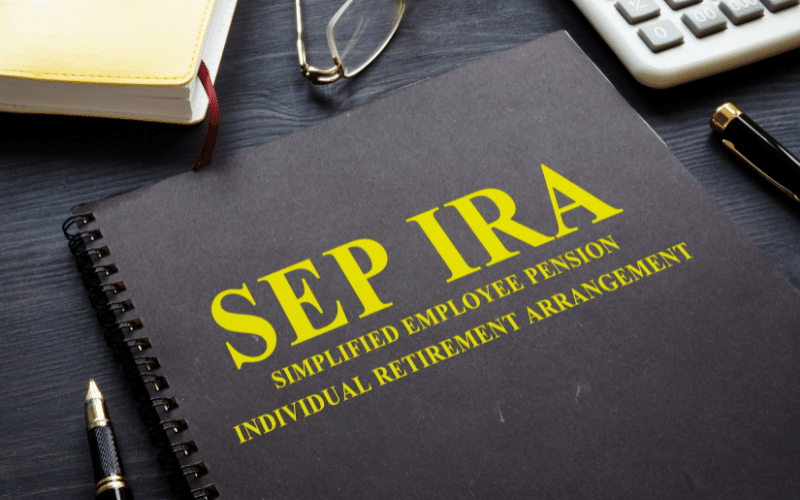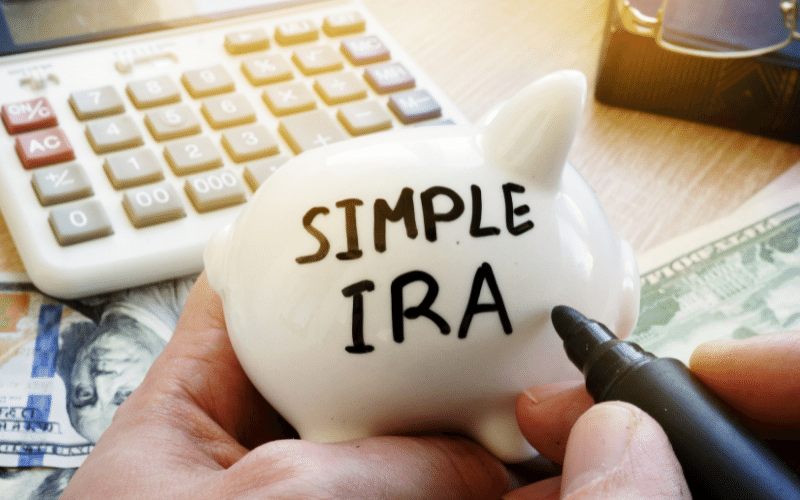Table of Contents

SEP IRA vs SIMPLE IRA
When it comes to retirement it’s best you know the right retirement plan for you. We will compare SEP IRA vs SIMPLE IRA retirement options. There are several options for business owners and self-employed individuals to set up a retirement account for themselves and their employees.
The SEP IRA and the SIMPLE IRA are two of the most popular, as they both provide many of the major tax advantages of a traditional IRA.
However, these plans also provide a way for business owners to avoid the administrative burdens associated with traditional retirement plans such as the 401(k).
While they share the IRA moniker with their more well-known cousins, the SEP IRA and SIMPLE IRA are intended for businesses, including sole proprietorships, rather than individuals. (If you’re an individual looking to set up a traditional or Roth IRA, you should look into the benefits of those plans.)
Here’s how the SEP IRA compares to the SIMPLE IRA, as well as the key differences to consider when choosing between the two plans.
What Exactly is a SEP IRA?

SEP is an abbreviation for Simplified Employee Pension, and it is a plan that is available to employers (including the self-employed).
Employers can avoid the time-consuming reporting requirements that the government typically imposes on retirement plans.
The employer is the only one who contributes to a SEP IRA. Employers may contribute up to 25% of an employee’s annual pay to the account, for a total contribution of $58,000 in 2021 and $61,000 in 2022.
The employer must contribute an equal percentage to all employees, though it may exclude those covered by a union agreement.
The employee is immediately fully vested in all SEP IRA contributions and has complete control over the funds. Employees can enjoy tax-deferred growth on all deposits with a SEP IRA until retirement.
In terms of distributions, a SEP IRA works similarly to a traditional IRA, with money taxed only when it is withdrawn.
If you withdraw funds from the account before the age of 59 12 months, you will typically be charged a 10% bonus penalty.
In addition, you must make required minimum distributions from the account in accordance with IRS regulations, which require distributions to begin at the age of 72.
What is a SIMPLE IRA?

SIMPLE stands for Savings Incentive Match Plan for Employees, and it is available to employers (including self-employed individuals) with no more than 100 employees who earned more than $5,000 in the previous year.
Employers can avoid the complex federal reporting requirements that are typical of a 401(k) plan by hiring a financial institution to manage the program.
Employees can have contributions deducted from their paychecks and deposited into their SIMPLE IRA account, where they can grow tax-free until retirement.
Employees can contribute up to $13,500 in 2021 and $14,000 in 2022, with those over 50 able to contribute an additional $3,000.
These elective deferrals contribute to the annual maximum on elective deferrals for this and other retirement plans.
Employers are required to contribute to their employees’ SIMPLE IRAs and have two options:
– Match employees’ contributions dollar for dollar, up to 3% of their earnings.
– Contribute 2% of employees’ wages up to a maximum annual compensation of $290,000 in 2021 and $305,000 in 2022.
When it comes to distributions, a SIMPLE IRA functions similarly to a traditional IRA. Only when money is withdrawn is it taxed.
If you withdraw the funds before the age of 59 12 or under certain special circumstances, the IRS may slap you with a 10% bonus penalty and a 25% levy.
According to IRS regulations, you must also begin taking required minimum distributions at the age of 72.
The Benefits and Drawbacks of a SEP IRA
The Benefits of a SEP IRA:
– Allows you (and your employees) to save for retirement: If you’re self-employed, you may not have many options for tax-advantaged retirement savings, so this can be beneficial.
– Tax-deferred: Because your contributions are made with pre-tax dollars, you receive a tax deduction today and pay taxes only when you withdraw the funds.
– Simple to set up: After filling out one IRS form, a broker offering SEP IRAs can walk you through a few simple steps.
– Immediate vesting: Employees benefit from immediate vesting on any employer match, which means the money is legally theirs as soon as it is deposited.
– Make larger contributions: Contribution limits are higher than those of traditional and Roth IRAs, as well as higher than those of 401(k) plans (k).
– Flexibility: You are not required to contribute every year (for yourself or your employees).
Drawbacks of a SEP IRA:
-The plan must treat employees in the same way that you do: A SEP IRA is a contribution made solely by the employer. Employees do not contribute on their own, and you are required to contribute the same percentage of employee compensation as you do to your own account.
– No catch-up contributions: There are no catch-up contributions for people over the age of 50, as there are with IRAs and 401(k)s. (However, the increased contribution limits of a SEP IRA may outweigh this disadvantage.)
– No Roth option: Those who prefer to save money with after-tax contributions and then withdraw it tax-free are out of luck. There is no Roth option, so while your money will grow tax-free, you will still owe taxes when you withdraw it.
– Penalties for early withdrawal: As with a traditional IRA, if you withdraw your money before the age of 59 12 months, you will be subject to taxes and a 10% bonus penalty.
– Required minimum distributions: Beginning at the age of 72, you must withdraw a minimum amount from the account.
The Benefits and Drawbacks of a SIMPLE IRA
Benefits of a SIMPLE IRA:
• Allows you (and your employees) to save for retirement: If you’re self-employed, the plan allows you to save more in a tax-advantaged account.
• Tax-deferred growth: All contributions can grow tax-free until withdrawn.
• Paycheck deductions: Employees can have their contributions deducted from their paychecks, just like in a traditional 401(k) plan.
• Employers can contribute to plans in two ways: match contributions dollar for dollar up to 3% of earnings or make non-elective contributions up to 2% of an employee’s salary up to the annual compensation limit of $290,000 for 2021.
• Immediate vesting: Employees benefit from immediate vesting on any employer match, which means the money is legally theirs as soon as it is deposited.
• Employee contributions are not reported as income: Because employee contributions are not reported as income, it appears that employees are contributing with pre-tax dollars.
• Higher contribution limits: Contribution limits are higher than in traditional and Roth IRAs, but not as high as in a 401(k) or SEP IRA.
• Catch-up contributions: Employees over the age of 50 can save an extra $3,000 per year as a catch-up contribution.
Drawbacks of a SIMPLE IRA:
• Limited to smaller businesses: To establish a SIMPLE IRA, employers must have no more than 100 employees earning more than $5,000 in the previous year.
• Employers must fund accounts: Each year, employers must fund their employees’ accounts.
• No Roth option: Because this plan does not have a Roth option, employees will be unable to save after-tax dollars and later take tax-free withdrawals.
• Penalties for early withdrawal: As with a traditional IRA, if you withdraw your money before the age of 59 12 months, you will be subject to taxes and a 10% bonus penalty.
• Required minimum distributions: Beginning at the age of 72, you must withdraw a minimum amount from the account.
SEP IRA and SIMPLE IRA contribution limits
| Plan | Contribution limit (2021) | Contribution limit (2022) |
| SEP IRA | $58,000 | $61,000 |
| SIMPLE IRA | $13,500 (plus $3,000 for those over age 50) | $14,000 (plus $3,000 for those over age 50) |
The main distinctions between SEP IRAs and SIMPLE IRAs
While the SEP IRA and SIMPLE IRA appear to be similar to traditional 401(k) programs, they differ significantly from one another.
Both programs are established by employers on behalf of their employees and follow the same distribution rules as a traditional IRA.
The following are significant differences between the two programs:
• The SEP IRA allows only employers to contribute to the plan; employees are not permitted to contribute.
• Employees can control how much money they save by contributing to the SIMPLE IRA with elective deferrals from their paychecks.
• Employers must contribute to their employees’ SIMPLE IRA accounts or risk being fined by the IRS. They have two options for making a contribution.
• Employers may contribute to a SEP IRA, but they are not required to do so.
• Employers can contribute up to $58,000 (in 2021) or up to 25% of an employee’s salary, whichever is less, to a SEP IRA. A SIMPLE IRA, on the other hand, allows employees to contribute up to $13,500 (in 2021), with employers able to contribute more.
Both plans are popular with small businesses, particularly those that are self-employed, due to their ability to save large sums of money in excess of what they can do in their own personal IRA. The solo 401(k) is another popular option for self-employed individuals (k).
In conclusion
The SEP IRA and SIMPLE IRA were created to provide a more robust vehicle for smaller employers, including self-employed individuals, to help employees save for retirement.
The plans have higher maximum contributions and offer different benefits, but it is up to employers to determine which plan is best for them and their financial situation.
Finally, self-employed individuals should consider another retirement plan, the solo 401(k), which provides a variety of additional benefits.